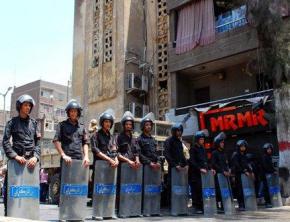An Army assault on Egypt’s Copts
The military attack on Egypt's Coptic Christian minority is designed to undermine the gains of the country's fledgling revolution, reports .
IN THE most violent clashes since the early days of Egypt's revolution, the army attacked and killed at least 24 protesters on October 9 in front of the Egyptian state television building, known as Maspero, in downtown Cairo.
More than 300 other people were wounded during the military's repeated assaults, directed at a group of Coptic Christians and their Muslim supporters who were marching from the working-class neighborhood of Shubra towards Tahrir Square.
In the days since the military's attack, competing accounts of what took place have emerged, with state-run media offering a version of events that directly contradicts the reports of protesters, eyewitnesses and journalists on the ground.
The assault on a march led by Egypt's Coptic Christian minority is an ominous sign of the willingness of the Supreme Council of the Armed Forces, which currently rules Egypt, to draw on anti-Christian sentiment in its bid to maintain its grip on power. The uprising that toppled Hosni Mubarak in February consciously organized to bring together Muslims and Copts, who make up about 15 percent of Egypt's population.

After the revolution succeeded in ousting the U.S.-backed dictator, forces opposed to the revolution's goals--including the military government and various religious groupings--have attempted to employ anti-Christian sentiment, as the Mubarak regime before it did, to divide and conquer.
The anti-Christian assault took place at a crucial moment for the regime, which has been facing increasing pressure in recent weeks by strikes involving more than half a million Egyptian teachers, doctors and public transport workers, despite the military's attempt to impose an anti-strike law.
MULTIPLE EYEWITNESSES have said that the initial march from Shubra was peaceful. The group of Copts and their Muslim supporters mobilized to protest the burning of a church and attacks on Christian shop owners in the town of Edfu in the Aswan governorate on September 30. Journalists and activists marching with the group reported that the march was briefly attacked by a group of young men in plainclothes, throwing rocks.
The demonstrators successfully repelled the thugs, however, and the march continued on to join a crowd of several hundred people in a stationary demonstration near Abdel Moneim Riyadh Square and the Sixth of October Bridge.
But chaos descended abruptly, despite the peaceful character of both demonstrations, when marchers encountered a large army presence massed near the Maspero building. Sharif Abdel Kouddous, a Democracy Now! journalist, recounts the events he witnessed at the scene:
Many armored personnel carriers were there, many hundreds of military police with batons, with shields, with helmets, lining the streets...But this scene turned into bloodshed and chaos in a matter of seconds. Some protesters pushed back some military police, pushed them back towards where the APCs were.
And then the military attacked. They came rushing forward, beating anyone in their path. Then they started opening fire. The sound of gunfire filled the air, and it was not stopping. Some people fell over as the stampede was coming back behind the Hilton Ramses, a hotel nearby.
Sarah Carr, a reporter with the Egyptian daily Al-Masry Al-Youm, detailed the ensuing horror:
Two armored personnel carriers (APCs) began driving at frightening speed through protesters, who threw themselves out of its path. A soldier on top of each vehicle manned a gun, and spun it wildly, apparently shooting at random, although the screams made it difficult to discern exactly where the sound of gunfire was coming from...
And then it happened: an APC mounted the island in the middle of the road, like a maddened animal on a rampage. I saw a group of people disappear, sucked underneath it. It drove over them. I wasn't able to see what happened to them because it then started coming in my direction.
These accounts were corroborated by multiple videos and photos spread virally on YouTube and Facebook, which showed the careening APCs and the gruesome crushed bodies of protesters brought to the Coptic Hospital. As volunteers attempted to reach the hospital to donate blood to the large numbers of wounded, a group of armed thugs attacked the hospital itself and prevented donors from entering the area.
The army and central security forces cordoned off a wide section of central Cairo--from Tahrir Square to Abdel Moneim Riyadh Square along Ramses and Galaa Streets, and then inward toward Talat Harb Square in downtown. The cordon prevented terrified residents, bystanders and protesters from escaping the bilious clouds of tear gas and smoke from the vehicles that had been set ablaze.
Additional video taken by witnesses shows unarmed demonstrators surrounded and simultaneously attacked by baton-wielding soldiers on one side and thugs armed with sticks on the other.
WHILE THE army continued the onslaught against protesters with live ammunition, Egyptian state television Channel One anchor Rasha Magdy carried out a propaganda campaign, repeatedly emphasizing on air that Coptic protesters were attacking soldiers--an inflammatory assertion blatantly contradicted by the facts. She ended her broadcast by calling on Egyptian protesters to defend the military from such "threats."
Rumors have circulated that armed protesters killed two or three soldiers, but army officials have refused to release any casualty information on soldiers, undermining such claims. In response to the state's campaign of propaganda, groups of Islamists and Salafists took to the streets, chanting, "The army and the people are one hand."
During the course of the unfolding violence, army units undertook concerted attacks on independent media outlets disseminating live video coverage of events. The Twitter account of al-Shorouk, one such independent media outlet, reported that power and phone lines to the building housing their offices and studios were cut shortly after they aired video footage of dead bodies in the entranceway to the Maspero building.
Army forces also entered al-Hurra television studios and cut off al-Hurra's broadcast of a live feed direct from Abdel Moneim Riyadh square that showed soldiers abusing protesters.
In addition to the massacre and these gross violations of freedom of the press, multiple eyewitnesses report that the army collected the bodies of murdered protesters and dumped them in the Nile to get rid of the evidence.
Prime Minister Essam Sharaf responded to the attacks in an official televised statement, blaming the unrest on foreign interference. He referred to "invisible hands" inciting sectarian violence, claiming that the army crackdown on peaceful protesters was the result of a "dirty conspiracy."
Prior to Sharaf's statement, provocateurs at the scene of the clashes accosted foreign and English-speaking journalists, demanding identification. One reporter with Ahram Online was set upon by an angry mob that accused him of being a spy. This correspondent and an Egyptian companion who is also a journalist were similarly harassed.
Such intimidation is simply the latest episode in the ongoing effort by Egyptian state media to stoke xenophobia and military council accusations of foreign meddling in domestic affairs.
One day following the assault at Maspero, the Coptic community gathered in the central cathedral in Abbasiyya to mourn the victims of military violence. Ahram Online confirms that among the dead are Mina Danyal, one of the heroes of the January 25 revolution, who survived previous central security attempts on his life; Wael Yunna, a journalist with Coptic TV; and Michael Mosaad, an activist and member of the Maspero Youth Coalition, the group which organized the initial march.
The funeral services have provided a focal point for the anger of the Coptic community, and furious protests persisted in Abbasiyya throughout the day. Chants in the Cathedral called for the downfall of the military government and of Field Marshal Mohamed Tantawi.
Coptic groups have now issued calls for a week of anger, and parties and movements across the political spectrum have in turn condemned state media and fiercely criticized the military government. As a result of the perceived instability, the Bourse, the Egyptian stock exchange, fell by billions of pounds.
THE ERUPTION of violence highlights the inability of the Supreme Council to rule the country politically. The army is primarily concerned with maintaining control over Egypt's population until such time as an amenable civilian leader can be installed through a managed electoral process.
However, the ongoing protests against the extended emergency law, along with the recent groundswell of strike actions among Egypt's workers, exacerbate the sharp political divisions among Islamist, liberal and left parties and challenge the military council's attempts to stage elections with any pretense of legitimacy.
As Islamist and centrist liberal parties align themselves with the military government in a bid for influence in the upcoming elections, militant student demonstrations calling for fair elections of university officials have forced out university presidents installed by Mubarak's National Democratic Party.
The April 6 youth movement has signed a solidarity statement with the global October 6 campaign, calling for electoral transparency and the purging of holdovers from the previous autocratic government.
The tension between revolutionary forces and reactionary forces places the Supreme Council in a precarious position. In its attempts to deflect criticism, the military council may have miscalculated. Clumsy attempts to slander murdered protesters as "foreign conspirators" have been exposed as propaganda by valiant activist reports and documentation of the true circumstances of the Maspero massacre.
The Coptic community, long a target of scapegoating to divide the public along sectarian lines, is not backing down, and left and liberal groups have allied with them against such crude military repression.
While the U.S. has attempted to wield its influence by pushing for the November elections to proceed, Egyptian commentators question whether the military council should continue to govern. There are also growing calls to replace the council with a civilian committee, an option that was rejected in the early days of the revolution as the military sought to cling to power.
As with the Battle of the Camel in February, the attacks on protesters at Abbasiyya in July, the crushing of the Tahrir occupation in August and the brutal pushback of central security forces against Egyptian youth at the Israeli embassy protests, each confrontation between demonstrators and state power renders stark the contrast between the authoritarian interests of the military government and the demands of the Egyptian people.
The martyrs of the Maspero massacre, along with a thousand other martyrs of the revolution, have paid the ultimate price for freedom. Their loss only strengthens the resolve of their colleagues and comrades to continue the revolution until the goals of social and economic justice have been achieved for all Egyptians.


